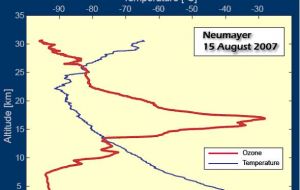MercoPress. South Atlantic News Agency
Antarctic ozone hole opens early this year but may not be as large

The hole in the Antarctic ozone layer has emerged earlier than usual this year, but it is not yet clear whether the eventual annual depletion of the naturally occurring gas that filters out cancer-causing ultraviolet (UV) radiation will be as bad as recent years, the United Nations meteorological agency announced Tuesday.
In its first Ozone Bulletin of 2007, the World Meteorological Organization (WMO) said initial readings indicate that the size and the depth of the ozone hole are similar to recent years at the same stage. "It is still too early to give a definitive statement about the development of this year's ozone hole and the degree of ozone loss that will occur," the bulletin stated, adding that it will depend on the meteorological conditions between now and early October, when depletion usually ends. But the area observed so far "could indicate that the 2007 ozone hole will be relatively small," the report added. The Antarctic ozone hole appears every year at the start of spring in the Southern Hemisphere as the sun returns to the continent after the long polar night. WMO and other scientists use observations obtained from satellites, weather balloons and other data to measure the rate of depletion. WMO expects the ozone hole to recur annually so long as the Earth's stratosphere contains an excess of ozone-depleting substances. The Montreal Protocol and Vienna Convention are designed to phase out chemicals such as chlorofluorocarbons (CFCs), but scientists have warned that it may be two decades before there is a clear decline in the size and depth of the annual holes.




Top Comments
Disclaimer & comment rulesCommenting for this story is now closed.
If you have a Facebook account, become a fan and comment on our Facebook Page!